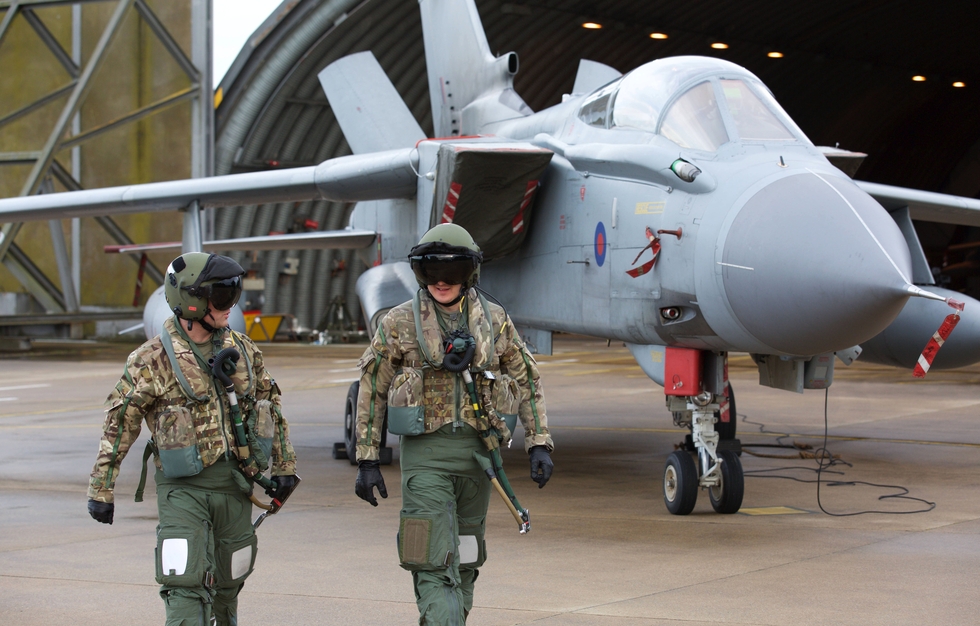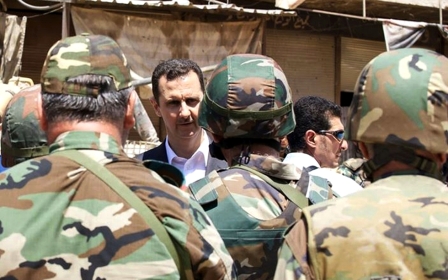British action in Syria: 33 strikes in just under three months

The British government's extension of its air campaign against the Islamic State group to Syria has resulted in 33 successful strikes in almost three months of operations, analysis of official figures by Middle East Eye shows.
Ministry of Defence reports show that since a Commons vote on 2 December, the RAF has used drones and manned aircraft to hit targets in Raqqa, nearby oilfields under IS control and several of its command sites.
But the frequency of the attacks has been low and appears to be stalling, from an initial flurry last year to a handful of successful strikes reported so far in February.
Analysis of the MoD’s published operational reports, while not comprehensive due to uneven reporting methods, amounts to less than one raid every two days in Syria up to and including 18 February – the last weekly report date from the MoD.
Many attacks have used Paveway guided bombs and Hellfire missiles, while advanced Brimstone missiles - which cost more than £100,000 each and which Prime Minister David Cameron said would make a "meaningful difference" - have been used sparingly.
Focus appears to remain on Iraq, where the RAF launched more than 100 successful strikes in December alone as it supported major offensives against IS in Sinjar to the north and Ramadi in the south.
The action compares to sometimes dozens of strikes a day by other forces in the US-led anti-IS coalition, and the scores of raids launched by Russia every day – although many of those are not targeting IS.
RAF Tornado strike on IS vehicle on Thursday, 18 February
British MPs on December 2 voted to support Cameron's plans to extend the RAF campaign to Syria. A large contingent of Labour MPs backed the Conservative prime minister after rejecting their leader Jeremy Corbyn's opposition.
During a Commons debate lasting 10 hours, Cameron said the crux of his argument was “not about whether we want to fight terrorism”, but “how best we do that", and stated that the air strikes would make the UK safer and form a “comprehensive strategy” to counter IS.
He stated there were 70,000 “moderate” fighters in Syria prepared to take on IS – a figure that was repeatedly questioned in the debate and never fully explained by the government.
David Davis, a Conservative MP who voted against the Syria campaign, said RAF bombing would be no more than "symbolic".
A spokeswoman for the MoD said that RAF efforts were focused on aiding allied forces in Iraq defeat IS, and destroying the group’s infrastructure in Syria.
“Obviously there is a lot more activity in Iraq. A lot of the fighting is still taking place. Our focus is supporting ground forces fighting IS in their country, and attacking IS infrastructure and revenue streams in Syria. That focus continues.”
The spokeswoman said that RAF operations had to be taken in context as part of a larger campaign by the international US-led anti-IS coalition.
“As of 18 February there have been 33 successful strikes,” she said. “Our tasking and targeting is led by the coalition. The Americans are in charge of the task list – they assign tasks to coalition members to ensure maximum effectiveness.
“We have say on whether to hit a target but the point to make is that if a target is identified in Syria, previously – even if our aircraft were nearest to the target – we would have said sorry we cannot hit it. Now we can.”
She added that the official tally of 33 successful strikes did not account for the number of actual successful attacks launched.
“We are part of the US-led coalition and go by their definitions – a strike is classed as a target destroyed.
"A large network of tunnels would take multiple bombs to destroy, whereas one terrorist would take one hit. They would both count as one successful strike, despite how many bombs were dropped or how many attacks were staged.”
The spokeswoman said the RAF had not reduced its sorties or its commitment over Syria.
Shashank Joshi, senior research fellow at the Royal United Services Institute (RUSI), told Middle East Eye he believes the UK's strategy has shown an astute understanding of the battleground against IS.
"The RAF is focusing on Iraq, making a valuable contribution to battlefield against Isis rather than expending lots of ordnance in Syria merely for show," he said, using an alternative acronym for IS.
"We knew that Syria presented a challenging target environment, with Isis adapting to strikes and minimizing their signature. We also know that the coalition enjoys more ground forces in Iraq than in Syria, making its air strikes more effective in the former.
"The Brimstone is expensive and it is a good thing that it's being used sparingly - I don't think profligate use would indicate seriousness of intent or prudent strategy."
However, Christopher Davidson, reader in Middle East politics at Durham University, says the British air strikes demonstrate how the approach to take IS has been one of "contain and react".
"This fits into the 'contain & react' approach that the US/UK/French governments have taken on the Islamic State," he said.
"Although purportedly an existential threat to Western civilization, the grim reality is that the group's survival and perhaps even expansion fits neatly with a host of strategic objectives including the upkeep of pressure on Damascus, on the Iran-leaning Baghdad government, and on NATO member Turkey's Kurdish enemies.
"On top of that, it's great for business with a whole host of international arms and security companies able to profiteer on the back of a ghastly new global spectre."
New MEE newsletter: Jerusalem Dispatch
Sign up to get the latest insights and analysis on Israel-Palestine, alongside Turkey Unpacked and other MEE newsletters
Middle East Eye delivers independent and unrivalled coverage and analysis of the Middle East, North Africa and beyond. To learn more about republishing this content and the associated fees, please fill out this form. More about MEE can be found here.




